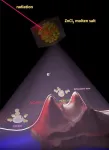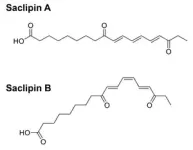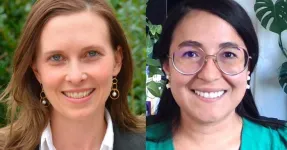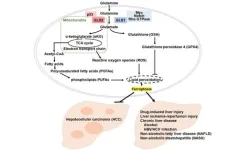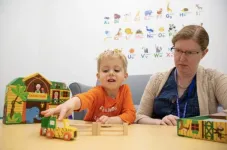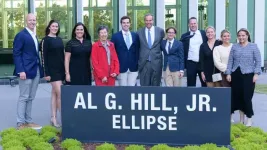(Press-News.org) In a finding that helps elucidate how molten salts in advanced nuclear reactors might behave, scientists have shown how electrons interacting with the ions of the molten salt can form three states with different properties. Understanding these states can help predict the impact of radiation on the performance of salt-fueled reactors.
The researchers, from the Department of Energy’s Oak Ridge National Laboratory and the University of Iowa, computationally simulated the introduction of an excess electron into molten zinc chloride salt to see what would happen.
They found three possible scenarios. In one, the electron becomes part of a molecular radical that includes two zinc ions. In another, the electron localizes on a single zinc ion. In the third, the electron is delocalized, or spread out diffusely over multiple salt ions.
Because molten salt reactors are one of the reactor designs under consideration for future nuclear power plants, “the big question is what happens to molten salts when they’re exposed to high radiation,” said Vyacheslav Bryantsev, leader of the Chemical Separations group at ORNL and one of the scientists on the study and an author of the paper. “What happens to the salt that is used to carry the fuel in one of those advanced reactor concepts?”
Claudio Margulis, professor of chemistry at the University of Iowa and also a study investigator and author, said, “Figuring out how the electron interacts with salt is important. We see from the study that, at very short times, the electron can facilitate the formation of a zinc dimer, a monomer, or be delocalized. It is conceivable that on longer time scales such species could further interact to form other more complex ones.”
In this study, the scientists wanted to understand how an electron, which appears because of radiation generated by nuclear fuel or other energy sources, will react with the ions that make up a molten salt.
“This study doesn’t answer all these questions, but it’s a start to investigate more deeply how the electron interacts with the salt,” Margulis said.
He continued: “Since our first-principles molecular dynamics calculations show that these three species can form in the melt at very short times, it begs the question of what other species can form at longer times. We do not have an answer for this. One option is that the electrons can return to the species where they came from; for example, a chlorine radical can take back an electron to form chloride. Another is that radical species may react in more complex ways. Of particular interest is the case when radiation generates enough radicals that these can be in close proximity; this is when they could react to form more complex species.”
The researchers, along with Iowa graduate student Hung Nguyen, published their findings in the American Chemical Society’s The Journal of Physical Chemistry B. The paper, “Are High-Temperature Molten Salts Reactive with Excess Electrons? Case of ZnCl2,” was chosen as an ACS Editors’ Choice, an honor bestowed on one paper from across the entire ACS portfolio that has particular potential for broad public interest. It has also been selected for the journal’s front cover.
The research was part of DOE’s Molten Salts in Extreme Environments Energy Frontier Research Center, or MSEE EFRC, led by Brookhaven National Laboratory. An EFRC is a basic research program funded by DOE’s Office of Basic Energy Sciences that brings together creative, multidisciplinary and multi-institutional teams of researchers to address the toughest grand scientific challenges at the forefront of fundamental energy science research.
“This research is important because it shows how the excess electrons generated by radiation in molten salt reactors could have multiple forms of reactivity. I and other members of the MSEE team are attempting to identify these other forms of reactivity experimentally,” said Brookhaven chemist James Wishart, director of the MSEE EFRC.
“This study can give us some understanding of how an electron can interact with a molten salt,” Bryantsev said. “There are a lot of questions still open. For example, is this interaction similar to what happens with other salts?”
Nguyen, the paper’s first author, said, “I continue to work with Professor Margulis, Dr. Bryantsev, as well as other members of the MSEE project to extend our studies by looking at other salt systems. Hopefully, we will be able to answer more questions on the effect of radiation on molten salts.”
The computational research was done at DOE’s Compute and Data Environment for Science at ORNL and the National Energy Research Scientific Computing Center at Lawrence Berkeley National Laboratory, both DOE Office of Science user facilities.
UT-Battelle manages ORNL for DOE’s Office of Science, the single largest supporter of basic research in the physical sciences in the United States. DOE’s Office of Science is working to address some of the most pressing challenges of our time. For more information, visit energy.gov/science. — Lawrence Bernard
END
Electrons are quick-change artists in molten salts, chemists show
2023-10-19
ELSE PRESS RELEASES FROM THIS DATE:
Communities of color experienced fear and mistrust of institutions during COVID-19 pandemic
2023-10-19
RIVERSIDE, Calif. -- A study led by researchers in the School of Medicine at the University of California, Riverside, has found that in communities of color in Inland Southern California, historical, cultural, and social traumas induce fear and mistrust in public health and medical, scientific, and governmental institutions, which, in turn, influence these communities’ hesitation to get tested and vaccinated for COVID-19.
The study, published in Culture, Medicine, and Psychiatry, underscores the need for community-based health interventions that consider structural and social determinants of health ...
Nail salon and other small beauty service workers face significant daily health challenges
2023-10-19
The beauty service microbusiness industry in the United States — such as the small, independently-owned nail salons found across the country — is huge, with more than $62 billion in annual sales.
However, most of the workers who provide these highly sought services are Asian female immigrants who earn very low wages. These workers face numerous workplace health challenges stemming from the chemicals they use, repetitive movements with handheld tools and awkward body posturing.
They also are reluctant to bring attention to these conditions due to factors such as possible immigration-related trauma, lack of English proficiency, ...
Pandemic prevention consortium announces new leadership team
2023-10-19
Recognizing the many milestones it has reached in recent months, Strategies to Prevent Spillover, or STOP Spillover, a project funded by the U.S. Agency for International Development (USAID) and led by Tufts University, has announced that the interim leadership team that was put in place in March 2023 will take on a permanent role for the next two years of the project.
Hellen Amuguni, an associate professor in the Department of Infectious Disease and Global Health at Cummings School of Veterinary Medicine, is the new project director. The co-deputy directors are Felicia Nutter, director of the International Veterinary ...
mRNA delivered by extracellular vesicles induces immunotherapy response in glioblastoma
2023-10-19
HOUSTON ― A team of researchers at The University of Texas MD Anderson Cancer Center has developed a new method for using extracellular vesicles to enhance responses to immunotherapy in glioblastoma, potentially opening the door for wider use of engineered messenger RNA (mRNA) for cancer therapy. The study was published today in Nature Communications.
Earlier this year, a team of researchers led by Betty Kim, M.D., Ph.D., and Wen Jiang, M.D., Ph.D.,developed a novel method for loading mRNA into extracellular vesicles, small structures created by cells to transport biomolecules and nucleic acids within ...
Point-of-care technology initiative awarded $8.9 million renewal
2023-10-19
UMass Chan and UMass Lowell’s point-of-care technology initiative awarded $8.9 million renewal
UMass Chan Medical School and UMass Lowell have received an $8.9 million award from the National Institutes of Health (NIH) for renewed support of their initiative to advance the development of home-based and point-of-care health technologies. The program aims to jumpstart new tools to address heart, lung, blood and sleep disorders, especially in underserved populations.
The Center for Advancing Point of Care Technologies ...
GLS2 shapes ferroptosis in hepatocellular carcinoma
2023-10-19
“[...] we hope that our findings will inform future decisions regarding treatment of liver disease.”
BUFFALO, NY- October 19, 2023 – A new editorial paper was published in Oncotarget's Volume 14 on October 19, 2023, entitled, “GLS2 shapes ferroptosis in hepatocellular carcinoma.”
In their new editorial, researchers Sawako Suzuki, Divya Venkatesh, Tomoaki Tanaka, and Carol Prives from Columbia University discuss ferroptosis regulation of GLS2 as a potential therapeutic strategy against liver diseases.
“More than a decade has passed since our group (1) as well as ...
Groundbreaking study on bilingual children with Developmental Language Disorder
2023-10-19
Amanda Owen Van Horne sits on the floor while a child mixes up cake batter in a play kitchen.
While at play, an intensive language therapy program is also underway for preschool-aged children with developmental language disorder (DLD) at the University of Delaware’s Treatment Efficacy and Learning Language (TELL) Lab. The child says, “Him cooking.” Owen Van Horne repeats back, “He is cooking.”
DLD is a problem with learning and using language not attributed to a hearing impairment or intellectual disability, according to DLD ...
The Trinity Family Foundation grants major gift to Center for BrainHealth to honor the memory of Al G. Hill, Jr.
2023-10-19
The Trinity Family Foundation has pledged a generous $4 million gift to the Center for BrainHealth to advance the science of brain health, in memory of Al G. Hill, Jr., a renowned Dallas entrepreneur and philanthropist.
The thoughtful investment will support burgeoning research at the Center for BrainHealth, focused on deepening our understanding of neuroplasticity – the brain’s lifelong ability to change, adapt, get stronger and work better.
In recognition and gratitude, the center’s ...
Research shows new documentation tool could help optimize seizure treatments in patients with epilepsy
2023-10-19
New research from the University of Colorado Anschutz Medical Campus studies a new tool that will help medical providers identify patients who are failing epilepsy treatments earlier in order to change treatment to rapidly optimize positive outcomes.
The study was published online today in Neurology® Clinical Practice, an official journal of the American Academy of Neurology.
The study was a quality improvement project that tested the implementation of an easy-to-use standardized electronic health record documentation tool, which dramatically improved the accuracy and completeness of important clinical documentation ...
Neuroscientists to reveal new insights into Alzheimer’s
2023-10-19
Dementia experts from UC San Francisco will join their peers from around the globe at the annual Clinical Trials on Alzheimer’s Disease (CTAD) conference in Boston from Oct. 24 to 27.
Presentations cover breakthroughs in therapies that clear amyloid – a hallmark of Alzheimer’s – and a symposium on patients with early Alzheimer’s symptoms who were treated with the anti-amyloid medication donanemab, which may be approved by the end of the year. Other topics include novel treatments, diagnostic blood biomarkers, amyloid-related imaging abnormalities (ARIA) and Medicare coverage.
This year’s ...
